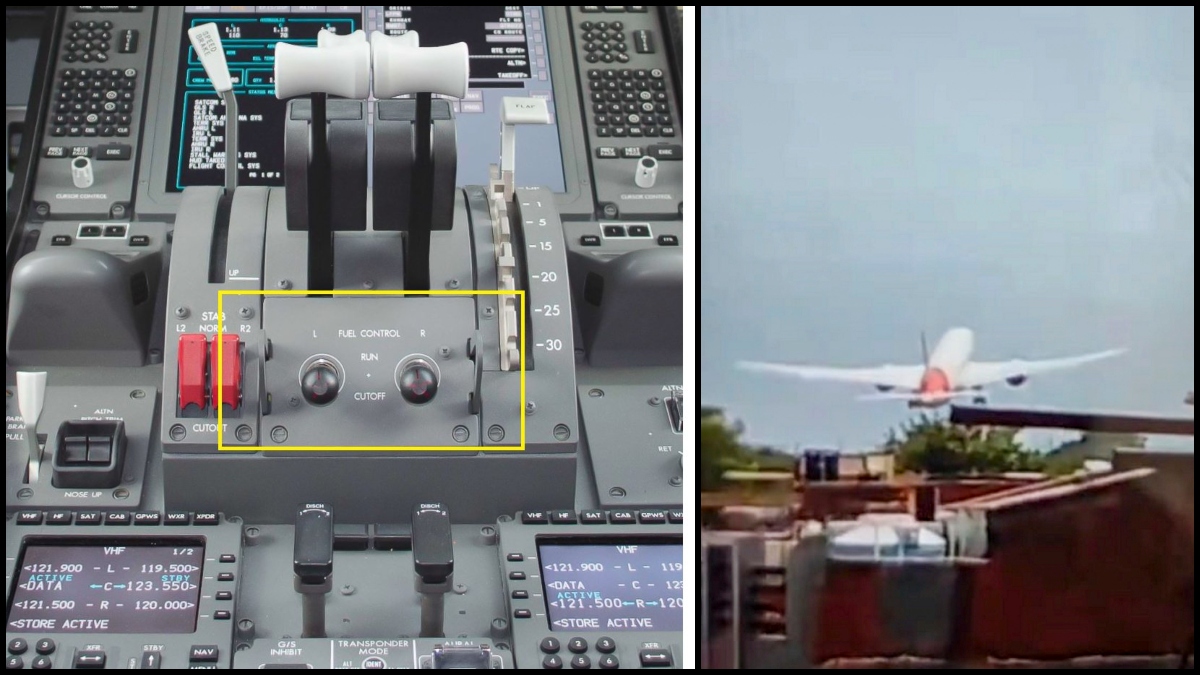AAIB Air India plane crash report: When and why pilots 'CUT OFF' cockpit fuel-control switches explained
 The fuel-control switches are a vital part of the cockpit controls | X
The fuel-control switches are a vital part of the cockpit controls | X
The Aircraft Accident Investigation Bureau (AAIB) preliminary report on the London-bound Boeing 787-8 Dreamliner's crash at Ahmedabad has brought the focus to the fuel-control switches of aeroplanes. Within a gap of a second, the fuel supply to both engines of the AI171 flight was cut off immediately after take-off, the AAIB report said.
ALSO READ | Engine malfunction, bird hit, fuel contamination: Conspiracy theories the AAIB crash report of Air India 171 rules out
"The aircraft achieved the maximum recorded airspeed of 180 Knots IAS at about 08:08:42 UTC, and immediately thereafter, the Engine 1 and Engine 2 fuel cutoff switches transitioned from RUN to CUTOFF position one after another with a time gap of 01 sec. The Engine N1 and N2 began to decrease from their take-off values as the fuel supply to the engines was cut off," it said.
What are fuel-control switches?
Fuel-control switches give pilots direct control over the fuel supply to the engines. Their primary function is to manage the flow of fuel for various operational phases and emergency situations. The two-mode switch ensures that the fuel flow to the engines are either on:
- RUN Mode: Allows fuel to reach the engine.
- CUTOFF Mode: Stops the fuel flow to the engine.
The fuel-control switches are moved to CUTOFF after the aircraft lands. If this happens when the flight is mid-air, the engines will no longer be served any fuel, triggering total power loss. It was mentioned in the report that the ill-fated Air India Flight 171's fuel-control switches were abruptly moved to CUTOFF seconds into take-off from Ahmedabad.
ALSO READ | Ahmedabad Air India crash: How did fuel supply CUTOFF to both engines of AI171 simultaneously after take-off? Boeing chief says...
How are fuel-control switches shut down?
If a fire is detected, the engine needs to be immediately cut off since fuel cannot be allowed to reach the blaze. If fire is sensed on an engine, its corresponding switch will alert the cockpit – demanding a shutdown. Since one engine can support the flight, isolating the fire-threatened engine poses no threat in the modern aviation sector. However, both engines being turned off and failing to gain thrust could be tragic.
Shifting fuel-control switches from RUN to CUTOFF is a two-stage process. Since an airborne flight cannot risk them being moved unintentionally, they are incorporated with necessary protection to avoid accidental activations. It is a manual operation and not connected to any automated system that could move them to CUTOFF, a report claimed. While Full Authority Digital Engine Control (FADEC) can manage engine relight when switches are moved to RUN, it cannot choose CUTOFF, it added.
Here is how the shutdown of the switch works:
For fuel-control switches to be shifted from RUN to CUTOFF, each has to be first lifted manually and then moved down. Since there is a switch for each of the engines, only if the procedure was performed twice could both engines be starved of fuel and forced into shutdown, an aviation expert was quoted as saying by the BBC.
ALSO READ | Were twin engines of Air India flight AI 171 turned off after takeoff? US sources claim no fault with Boeing 787-8 Dreamliner
In the case of Air India Flight 171, this is believed to have happened shortly after take-off, causing both engines to lose thrust and the plane to go down.
However, the recovered cockpit conversation recording confirmed that the pilots were not unaware of the activated fuel CUTOFF switches. An air accident investigation expert told the BBC that the pilots did turn the engines back on after they realised the engines were losing thrust, causing a loss of altitude. It is likely that the left engine was pushed back on first, followed by the right.
The systems are capable of going for an automatic engine relight once the switch is returned to RUN, but it is not guaranteed that it could restore full engine power. Sadly, this was the case on June 12, as there was not enough time for the right engine to recover and create enough thrust to pull the Dreamliner back up before it came into contact with the buildings.
Can machine malfunction make the switches shut down?
These switches and their fuel valves even have separate power and wiring systems for redundancy. They are "spring-loaded to close" or, in plain terms, fail-safe. This means if they lose electricity, they will automatically become CUTOFF, stopping fuel flow to prevent uncontrolled operation.
However, a major software or electrical glitch could still affect their functioning. But this would not be some minor issue, rather one of such magnitude that the multiple power sources are neutralised from powering the switch.
Default CUT OFF mode?
The report also mentioned a Special Airworthiness Information Bulletin (SAIB) by the Federal Aviation Administration (FAA) from December 2018, regarding some Boeing 737 fuel control switches being installed with the locking feature disengaged.
According to the BBC, the issue was not ignored but was not ruled an unsafe condition requiring an Airworthiness Directive (a legally binding order issued by aviation authorities ordering aircraft owners and operators to inspect, repair, or modify a specific part or system due to a safety concern).
The switch design in question was used in Boeing 787-8 aircraft, including the Air India plane that crashed, the news article said.
Who are involved in the crash probe?
Experts from Boeing, General Electric, Air India, and participants from the US National Transportation Safety Board and the UK are included in the investigation led by Indian administration and regulators.
India